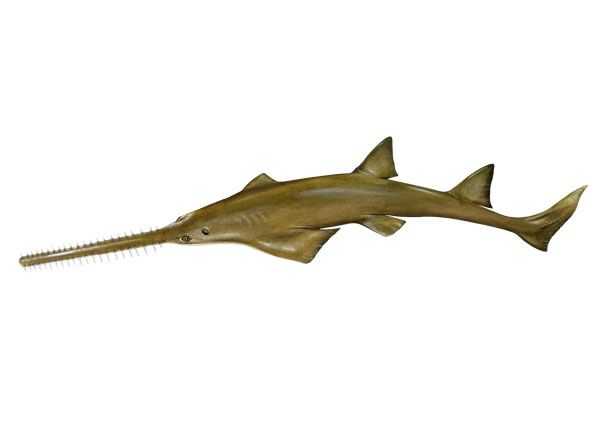Smalltooth Sawfish

Species Details
Pristis Pectinata
Pristidae
Rhinopristiformes
Onshore, Nearshore, Backcountry
600 - 770 lbs.
15" - 25"
Smalltooth Sawfish (Pristis pectinata) Fish Description
The Smalltooth sawfish is the only other sawfish in the Atlantic, next to the Largetooth sawfish. It has a brown-grey, grey, blue-grey or black color on the upper parts of its body, and a white underside.
In contrast to the Largetooth sawfish, the Smalltooth sawfish has a leading edge on both the dorsal and pelvic fins roughly placed above one another. It also has quite short pectoral fins and little to no distinct lower lobe to its tail.
They have a narrow saw, or rostrum, with 20-32 teeth on each side.
You can distinguish the Smalltooth sawfish from similar sawfish, such as the dwarf and green sawfish, by their distribution as both could only be found in the Indo-Pacific and their dorsal fins leading edge is located slightly or especially behind the leading edge of their pelvic fins.
Diet and Size
Smalltooth sawfish consume a variety of prey, such as fish and invertebrates like shrimp and crabs.
They use their rostra primarily by seining them from side to side to impale and stun their prey. Their rostra, which contains electro-sensitive organs in it, since the weak amount of electricity coming from other animals that help sawfish locate shrimp or crabs on the seafloor.
The Smalltooth sawfish can grow up to the total length of 18.2ft and weigh up to 770 lbs.
Interesting Facts about Smalltooth Sawfish
- The Smalltooth Sawfish’s teeth can continue to grow throughout their lifespan.
- A Smalltooth Sawfish's body is made entirely of cartilage.
- The “teeth” seen on a Smalltooth Sawfish's snout is not real. They're more like soft spines.
- There are only 5000 Smalltooth Sawfish left in the world.
- Smalltooth Sawfishes can sometimes be confused with Sawsharks
- Check where the gills are. The gills of a Smalltooth Sawfish are under them whereas the one of a Sawshark is more on their sides.
Smalltooth Sawfish - Conservation Status
The Smalltooth Sawfish is considered to be a critically endangered species that have already disappeared from most of its historically known range and is prohibited from fishing.
The main causes of its endangerment are due to habitat loss and bycatch. Juvenile Smalltooth Sawfish heavily relied on shallow habitats with plenty of vegetation, especially in red mangroves as their nursery areas, but with the changes of development in Florida and among other southeastern states has destroyed much of this habitat.
Another reason would be by means of bycatch, or Smalltooth Sawfish being accidentally caught in fishing nets. Since these fish posed a potential threat to hurt fishermen and destroy their gear, they were often killed instead of being released unharmed into the ocean. However, this threat has been widely reduced with the enactment of the Florida Net Ban Amendment, enacted in 1995.
Habitat and Distribution
The Smalltooth sawfish can be found in the tropical and subtropical parts of the Atlantic, the Caribbean, and the Gulf of Mexico.
The smallest fish in the sawfish species' original range consisted of covering around 810,000 square miles. The Smalltooth sawfish once had ranged from the United States to Uruguay in the West and from Senegal to Angola from the east of the globe. However, much of it has disappeared from its range and is in critical condition as an endangered species.
They are found inhabitant of coastal marine and estuarine brackish waters of less than 26 ft depth. Adult sawfish, at times, can be observed offshore as well, at depths up to 400 ft.
On occasions of increased salinity, juvenile Smalltooth sawfish can be found far up rivers.
Often, they are seen in places with soft sandy areas or muddy bottoms, but not limited to that as they can be found over at hard, rocky bottoms or even coral reefs. The Smalltooth sawfish can commonly be found in areas predominantly with mangroves or seagrass.





